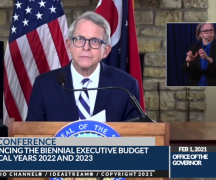BY NICK EVANS
Earlier this week Gov. Mike DeWine signed an operating budget covering the next two years. The budget is projected at $86 billion for fiscal year 2024 and $105 billion for fiscal year 2025.
At a press conference Wednesday, the governor touted the administration’s wins, explained some of his vetoes, and hinted at next steps after some of the package’s policy changes.
Victory lap
DeWine laid out a range of priorities in his state of the state speech this January, and he took time out to thank lawmakers for including many of those provisions in the budget. Often, DeWine didn’t get everything he wanted. But when it came to nursing home, behavioral health, housing, and education policy, the governor claimed accomplishments.
One major ask was for lawmakers to put dollars behind the science of reading, which emphasizes phonics. After a bit of wrangling between the chambers, lawmakers agreed to fund the initiative.
“Spreading the science of reading to every school in the state,” DeWine said, “so that every child is taught what we now know is the best way to learn to read, will be our first and number one priority.”
Also on the education front, DeWine praised new funding for career tech, touted the expansion of the Ohio College Opportunity Grant, and the creation of a new merit scholarship for the top 5% of high schoolers.
But another major ask didn’t go quite as well. On the heels of landing Intel’s next production facility, DeWine urged lawmakers to put $2.5 billion into developing more shovel-ready sites. In the end lawmakers agreed to about a quarter of that amount. Still, Lt. Gov. Jon Husted saw nothing but silver linings.
“They also put in $350 million for brownfields, $150 million for demolition, $124 million for water, and additional $500 million for rural road infrastructure,” he rattled off. “So when you combine all of this together, we believe we have what we need to create many, many more job ready sites across the state of Ohio.”
The administration’s last-minute push for social media parental consent legislation proved successful as well.
The vetoes
DeWine wound up issuing 44 line-item vetoes. That’s notably higher than previous budgets — 25 in 2019, and 14 in 2021. And it’s a point that House minority leader Allison Russo raised in a statement.
“The governor’s significant number of vetoes reflects a state budget that, I believe, needed more work,” she said. Democrats urged DeWine to veto provisions dissolving the elected state school board, expanding school vouchers, and shielding much of the state’s opioid settlement fund from public scrutiny. DeWine didn’t take them up on it.
DeWine and Democrats were copasetic on a few issues, but none of them should be a surprise. On his decision to turn down broad new vaccine exemptions for universities, DeWine said, “I think those of you who followed me through the pandemic would not be surprised by that.”
DeWine also snuffed out a number of tobacco and vaping provisions usurping local control. That’s in line with a rather forceful veto he made just a few months ago on virtually identical legislation. The governor said he’d sign legislation outlawing any flavored tobacco or vaping product in the state.
Other vetoes showed the governor reining in lawmakers’ ideas on spending. He turned down a bid to move interest from the rainy-day fund into the general revenue fund. Likewise, he cut language that would exempt a fund for plugging gas wells from any transfers to balance the general revenue fund. DeWine also rebuffed an attempt to impose stricter limits on year-over-year spending that didn’t take potential inflation into account.
Another veto carved out the specifics, leaving an expanded sales tax holiday a bit fuzzy. Instead of running the holiday for at least two weeks, as lawmakers proposed, the governor’s veto lets state and county authorities determine the duration.
“We don’t know how much money that would be,” DeWine said about the initial idea. “We don’t know what the sales would be. We don’t know how many Ohioans would take advantage of that. We don’t know how many Ohioans would not spend money for a while and then decide they want to go and put it all in that period of time.”
What’s next
Among the administration’s wins are two new cabinet level agencies. The governor specifically asked in his state of the state address for a new Department of Children and Youth. Lawmakers handed him that and also restructured the Department of Education to put it squarely under the governor’s authority.
“We’ll be making some announcements in regard to that shortly,” DeWine said. “We already have a transition team that’s been working prior to the passage of the budget. We’re gonna continue to work and we’re gonna do this as quickly as we can, but as carefully as we can as well.”





